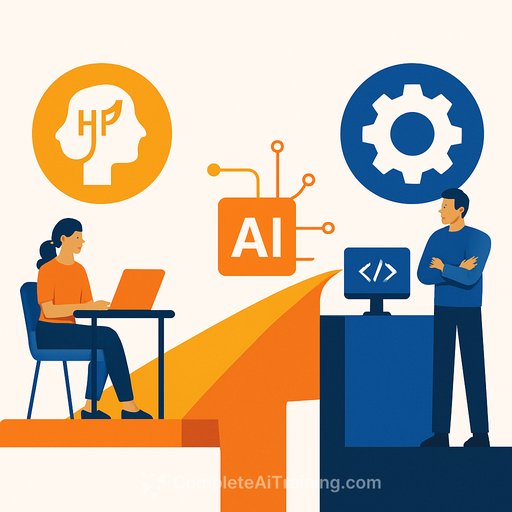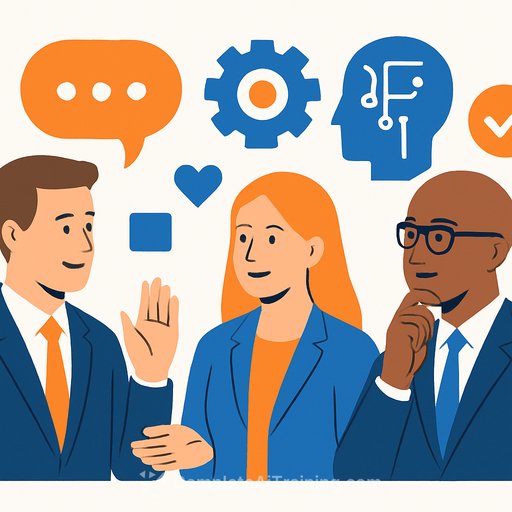AI is set to narrow HR's gender skills gap - here's how people leaders can make it real
Fresh UK data signals a shift: AI will shrink the gender skills gap in HR and other office-based, research and admin-heavy roles. Published to coincide with International Equal Pay Day, the analysis from Ainigma points to HR as one of the biggest beneficiaries - if leaders embed AI into everyday work, access, and progression.
It also flags a warning: in industries where men dominate AI building and deployment, gaps could widen unless leadership acts. For HR, this is an opportunity to lead by example and set standards that other functions can follow.
International Equal Pay Day and ONS research on the gender pay gap provide added context for why this matters now.
Top UK sectors where AI will close the gender skills gap
- Legal services
- Financial services / insurance
- Public sector
- HR & recruitment
- Journalism
- Marketing & advertising
- Education administration
- Healthcare administration
- Charity
- Retail management / E-commerce
Top UK sectors where AI may increase the gender skills gap
- Construction & skilled trades
- Manufacturing & engineering
- AI & tech development
- Transport & logistics
- Energy & utilities
- Investment banking & private equity
- Venture capital
- Scientific R&D (life sciences / pharmaceuticals)
- Creative arts
- Skilled agriculture
The trend is clear: roles built on research, documentation, policy, casework, and admin stand to gain. Where physical tasks dominate, the uplift is smaller - and access to AI tools often sits with a narrow group of decision-makers.
One insight will raise eyebrows: AI development itself may see the gap widen. Men still lead many of the roles that define, select, and deploy AI tools, which can bake bias into systems and influence outcomes across other sectors.
What this means for HR teams
AI won't boost the raw skills of top performers as much as others - but their strategic value jumps. The people who can combine judgment, context, and AI fluency will define how teams use tools, set standards, and create fair processes.
That puts HR in the driver's seat. You can turn this from a trend into measurable progress across hiring, learning, performance, and progression.
A practical playbook to narrow the gap with AI
- Baseline access: Give every HR professional the same toolset, usage rights, and data access rules. Don't restrict AI to a few "power users."
- Role-by-role task mapping: Identify repetitive work where assistants can help (policy drafts, job specs, screening notes, interview guides, ER case summaries).
- Skills uplift at scale: Run short, job-relevant training sprints for all HR levels. Focus on prompts, QA, data privacy, and bias checks.
- Bias controls: Standardize prompts, use rubrics, and keep human review for critical decisions. Log model inputs/outputs for audit.
- Career pathways: Recognize AI-enabled work in performance criteria. Reward documentation, reuse of prompts, and knowledge sharing.
- Equity by design: Track usage by gender, seniority, contract type, and location. Close access and training gaps fast.
- Guardrails and governance: Set clear rules for confidential data, approvals, and vendor selection. Involve ER, Legal, and DEI early.
- Measure what matters: Monitor throughput, quality, error rates, and time-to-complete by cohort. Tie outcomes to promotion and pay decisions.
Where to start this quarter
- Pilot in HR operations: policy updates, internal comms, learning content, and case summaries. Track time saved and quality.
- Standardize AI for hiring: structured prompts for job descriptions, interview questions, and candidate feedback to reduce variance.
- Upskill people managers: short sessions on safe AI use for feedback, performance notes, and development plans.
- Create an AI guild: nominate champions across HRBPs, TA, L&D, and ER to share prompts, use cases, and outcomes.
As Ainigma's CEO Arne Mosselman notes, the step change happens when staff are empowered and AI is embedded into standard processes. Bottom-up adoption, aligned to business goals and managed fairly, is the difference between progress and a wider gap.
HR's edge: fair implementation
HR can influence tool selection, training access, and governance across the business. Use that leverage to prevent AI fluency from becoming a new barrier to entry.
Done well, AI lifts throughput and frees time for higher-value work - policy clarity, workforce planning, capability building, and culture. That's where the leadership premium grows.
Level up your team's AI fluency
If you're setting up an internal programme or need role-based training paths, explore these resources:
- AI courses by job function (including HR)
- Practical certification: ChatGPT for workplace productivity
The opportunity is here. Equip your people, set fair rules, and make AI part of how work gets done. The gap closes when access, skills, and incentives line up.
Your membership also unlocks:






